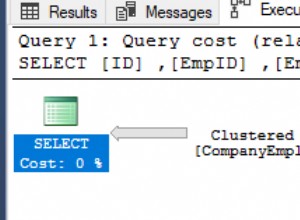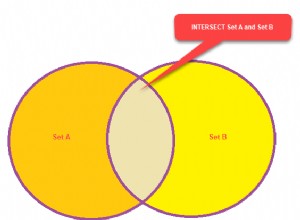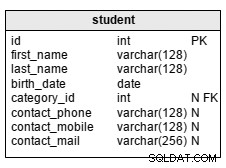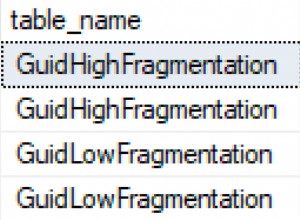GraphQL jest niezależny od bazy danych, więc możesz użyć wszystkiego, czego zwykle używasz do interakcji z bazą danych i użyć resolve zapytania lub mutacji metoda do wywołania zdefiniowanej przez Ciebie funkcji, która pobierze/doda coś do bazy danych.
Bez przekaźnika
Oto przykład mutacji przy użyciu opartego na obietnicach konstruktora zapytań Knex SQL, najpierw bez Relay, aby poznać koncepcję. Zakładam, że utworzyłeś userType w swoim schemacie GraphQL, który ma trzy pola:id , username i created :wszystko wymagane i masz getUser już zdefiniowana funkcja, która wysyła zapytanie do bazy danych i zwraca obiekt użytkownika. W bazie mam też password kolumna, ale ponieważ nie chcę tego zapytania, zostawiam go poza moim userType .
// db.js
// take a user object and use knex to add it to the database, then return the newly
// created user from the db.
const addUser = (user) => (
knex('users')
.returning('id') // returns [id]
.insert({
username: user.username,
password: yourPasswordHashFunction(user.password),
created: Math.floor(Date.now() / 1000), // Unix time in seconds
})
.then((id) => (getUser(id[0])))
.catch((error) => (
console.log(error)
))
);
// schema.js
// the resolve function receives the query inputs as args, then you can call
// your addUser function using them
const mutationType = new GraphQLObjectType({
name: 'Mutation',
description: 'Functions to add things to the database.',
fields: () => ({
addUser: {
type: userType,
args: {
username: {
type: new GraphQLNonNull(GraphQLString),
},
password: {
type: new GraphQLNonNull(GraphQLString),
},
},
resolve: (_, args) => (
addUser({
username: args.username,
password: args.password,
})
),
},
}),
});
Ponieważ Postgres tworzy id dla mnie i obliczam created znacznik czasu, nie potrzebuję ich w moim zapytaniu dotyczącym mutacji.
Droga przekaźnikowa
Korzystanie z pomocników w graphql-relay pomogło mi trzymanie się całkiem blisko zestawu startowego Relay Starter Kit, ponieważ było to dużo do ogarnięcia na raz. Relay wymaga skonfigurowania schematu w określony sposób, aby mógł działać poprawnie, ale idea jest taka sama:użyj swoich funkcji do pobierania lub dodawania do bazy danych w metodach rozwiązywania.
Jednym ważnym zastrzeżeniem jest to, że sposób przekazywania oczekuje, że obiekt zwrócony przez getUser jest instancją klasy User , więc będziesz musiał zmodyfikować getUser aby to dostosować.
Ostatni przykład z użyciem Relay (fromGlobalId , globalIdField , mutationWithClientMutationId i nodeDefinitions wszystkie pochodzą z graphql-relay ):
/**
* We get the node interface and field from the Relay library.
*
* The first method defines the way we resolve an ID to its object.
* The second defines the way we resolve an object to its GraphQL type.
*
* All your types will implement this nodeInterface
*/
const { nodeInterface, nodeField } = nodeDefinitions(
(globalId) => {
const { type, id } = fromGlobalId(globalId);
if (type === 'User') {
return getUser(id);
}
return null;
},
(obj) => {
if (obj instanceof User) {
return userType;
}
return null;
}
);
// a globalId is just a base64 encoding of the database id and the type
const userType = new GraphQLObjectType({
name: 'User',
description: 'A user.',
fields: () => ({
id: globalIdField('User'),
username: {
type: new GraphQLNonNull(GraphQLString),
description: 'The username the user has selected.',
},
created: {
type: GraphQLInt,
description: 'The Unix timestamp in seconds of when the user was created.',
},
}),
interfaces: [nodeInterface],
});
// The "payload" is the data that will be returned from the mutation
const userMutation = mutationWithClientMutationId({
name: 'AddUser',
inputFields: {
username: {
type: GraphQLString,
},
password: {
type: new GraphQLNonNull(GraphQLString),
},
},
outputFields: {
user: {
type: userType,
resolve: (payload) => getUser(payload.userId),
},
},
mutateAndGetPayload: ({ username, password }) =>
addUser(
{ username, password }
).then((user) => ({ userId: user.id })), // passed to resolve in outputFields
});
const mutationType = new GraphQLObjectType({
name: 'Mutation',
description: 'Functions to add things to the database.',
fields: () => ({
addUser: userMutation,
}),
});
const queryType = new GraphQLObjectType({
name: 'Query',
fields: () => ({
node: nodeField,
user: {
type: userType,
args: {
id: {
description: 'ID number of the user.',
type: new GraphQLNonNull(GraphQLID),
},
},
resolve: (root, args) => getUser(args.id),
},
}),
});




